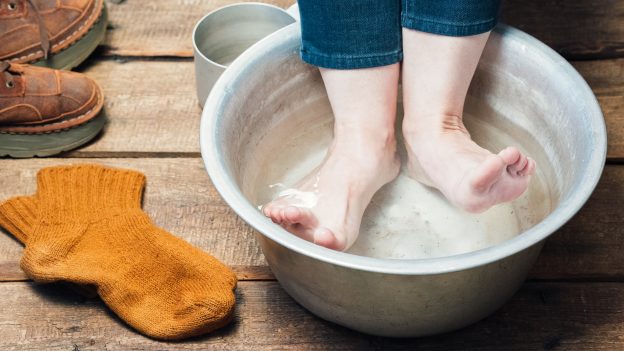Whether you’d like to build a snowman or hit the slopes, make sure you keep safety in mind when having fun in the snow this winter.
Frostbite occurs when body tissues freeze due to prolonged exposure to cold temperatures. Your toes and feet are especially vulnerable, as are your ears, nose, cheeks, chin and fingers.
While mild frostbite often heals successfully, moderate or severe cases may cause permanent damage without proper treatment. In some patients, frostbitten tissues may require amputation.
Here’s what you need to know to stay safe and avoid the worst effects of frostbite the next time you head outside on a cold day.
Frostbite Causes & Risk Factors
Frostbite can happen to anyone when temperatures fall below freezing, especially when the mercury plunges to single digits or lower on the Fahrenheit scale.
Factors that increase your risk of frostbite include lack of warm shoes and clothing, as well as windy conditions which cause the body to cool more rapidly. You may be more susceptible if your clothes are too tight, as this constricts your blood flow. Alcohol or drug impairment may also increase the risks associated with prolonged cold exposure.
Some medications may make you more prone to frostbite, as can a number of medical conditions. A few examples include:
- Diabetes
- Peripheral artery disease
- Peripheral neuropathy
- Raynaud phenomenon
Stages & Symptoms of Frostbite
Frostbite often causes numbness or a “needles and pins” sensation. Affected areas may appear red and swollen. Frozen skin may feel hard to the touch and develop a waxy texture. Many patients feel pain as frostbitten areas become warm again, and the skin may develop blisters.
Frostbite also ranges in severity from mild (also known as frostnip) to moderate (superficial) to severe.
Stage 1: Frostnip
Mild frostbite, or frostnip, can usually be treated at home with basic first aid, such as soaking in warm water. Symptoms typically include redness or a pale whitening of skin. Affected areas often feel cold, numb or tingly. You may develop small bumps as the skin heals.
Stage 2: Superficial Frostbite
If superficial, or moderate, frostbite is suspected, seek prompt medical attention to determine the appropriate course of treatment. With moderate frostbite, the moisture inside the skin actually freezes to form ice crystals, which may swell and cause a stinging sensation. Affected skin may develop fluid-filled blisters or purple or bluish patches that look similar to a bruise. Some patients experience skin peeling similar to what happens with a sunburn.
Stage 3: Severe Frostbite
Seek medical care immediately if severe frostbite is suspected. This occurs when lower layers of tissue freeze and total numbness sets in. One tell-tale sign of severe frostbite is when affected areas become difficult to move. For example, you may not be able to bend your toes or fingers.
Affected skin will develop large blisters within one or two days. In some cases, affected cells will die, causing the skin and underlying tissues to turn black. The blackened skin may fall off on its own or require surgical removal, including the possibility of amputation.
Frostbite Treatment & When to Seek Medical Attention
Time is of the essence for avoiding the most severe consequences of frostbite. Get inside as quickly as possible if you or a companion experience any symptoms, including numbness, pain or swelling. Keep in mind that refreezing of thawed tissue can cause even further damage, so only begin treating frostbite once the victim reaches a warm location. It’s also best to avoid walking on frozen feet or toes.
First Aid and At-Home Treatment
Thaw frostbitten areas gradually, using warm water or a warm washcloth. A good rule of thumb is to soak in water of about 105° Fahrenheit for no more than 30 minutes. Never use direct heat sources, such as a heating pad, stove or furnace, as these increase the risk of burning. After soaking, gently wash, dry and cover the affected areas to keep them clean and reduce the risk of infection. Wrap frostbitten toes or fingers individually to keep them separate, and don’t rub, as this can lead to worse damage.
It is normal to feel a tingling or burning sensation as frostbitten skin thaws and blood flow returns to normal. If blisters form, don’t rub or break them! Instead, keep the skin clean as it heals. Use over-the-counter pain medication as needed, and ask your healthcare provider whether an oral or topical antibiotic is necessary.
When to Seek Medical Care
Seek prompt, professional medical attention if you suspect moderate or severe frostbite. Warning signs include a loss of sensation that doesn’t return with rewarming and if the skin begins to turn gray.
When you arrive at the emergency room or urgent care center, the medical team will rewarm affected areas, dress them in sterile bandages and test for normal blood flow. You may receive intravenous fluids to improve blood circulation. Antibiotics may be prescribed to help you avoid infection. If you are at risk of tetanus, you may receive a tetanus booster shot. Some patients also receive hyperbaric oxygen therapy, which increases blood oxygen levels and promotes healing.
Complete healing from frostbite can take months. As noted earlier, some patients may require surgery or even amputation to remove dead tissue, such as fingers or toes.
Recovery & Prognosis for Frostbite
With mild frostbite or frostnip, symptoms are often temporary and heal on their own with at-home care. To promote recovery, stay inside and elevate the affected areas. Avoid walking on injured feet or toes if they hurt. Wear loose-fitting clothes and socks for greater comfort, and take anti-inflammatory and pain medications as needed.
Permanent damage may occur after moderate or severe frostbite. Patients with moderate frostbite may experience ongoing numbness and increased sensitivity to cold and pain.
Severe frostbite may leave you with long-term damage to muscles, bones and tendons. Patients may be at greater risk of developing arthritis, bone deformities, general weakness and changes to skin and nail texture. As noted earlier, some people may require amputation of dead tissues.
Tips for Preventing Frostbite
The best way to prevent frostbite is to simply stay inside when the temperature drops below freezing. If you must go outside, don’t stay out longer than 10 to 15 minutes.
Protect against frostbite by dressing in layers to stay warm, comfortable and safe. Your first layer should be a moisture-wicking fabric. The second layer should be a good insulator, such as wool or fleece. Your top layer should be a weatherproof material that keeps ice, snow and moisture away from your body.
Protect your feet and toes by wearing two pairs of socks when it’s below freezing. Your first pair should be a moisture-wicking fabric and your second should be an insulator such as wool. Wear boots in a waterproof material that cover your ankles.
Protect your head with a heavy wool or fleece hat, and cover your face with an insulating scarf or mask. Keep your hands safe with insulated gloves or mittens. Make sure all clothing isn’t too tight to avoid hurting circulation.
Finally, you can help your body ward off frostbite by staying hydrated and avoiding alcohol when spending time outdoors.
By knowing how to protect yourself and what to do if symptoms occur, you can reduce your risk of the most severe effects of frostbite.
And check out our full line of Baby Foot peels and other products to keep your feet soft and smooth year round.


